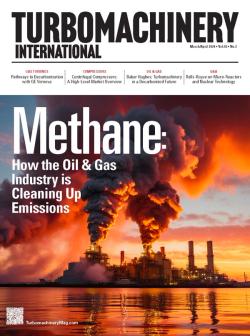
OR WAIT null SECS
© 2024 MJH Life Sciences™ and Turbomachinery Magazine. All rights reserved.
MYTH: GAS TURBINES ARE UNSAFE IN AN OFFSHORE ENVIRONMENT
We recently heard a great case of “the pot calling the kettle black” by some of our esteemed colleagues of the turbomachinery industry. Proponents of electric motor-driven compression cited the inherent dangers of using a gas turbine (GT) as a driver in offshore applications.
They argued that GTs may cause safety issues as gas leaks, hot exposed surfaces, or ingested combustible gas could potentially cause explosions. Yet thousands of units and millions of safe GT operating hours have already occurred offshore.
We could counter about the inherent danger of high-voltage electricity, the potential of arcing induced fires, and wiring shortcuts disabling entire platform safety systems. Instead, we will focus on pro-safety arguments for today’s state-of-the-art offshore GT installations. Of course, this assumes proper maintenance and general adherence to established safety standards and protocols.
Mandatory safety standards
There have been a few serious accidents in the past resulting from ignition of combustible gases offshore. This led to mandatory safety standards and requirements, such as NEC NFPA 70 and similar IEC standards.
NFPA requires the proper classification of areas on a platform where combustible gas can be present, as opposed to areas that are considered safe and where no combustible gas is to be expected. A basic safety requirement is identification of the hazardous classification areas on the platform and ducting the combustible gases away from them to a safe area.
Of course, gas leaks can and will occur in offshore applications, or for that matter, in any hydrocarbon installation. These can come from leaking valves, seals, pilots, vents, pneumatic supplies and, although rare, from ruptured pipes.
Potential leak sources can be analyzed using validated computational fluid dynamics (CFD) modeling including flow profiles, flow velocities, thermal gradients, and gas dispersion profiles. Hot surfaces, when in contact with flammable fuel, can lead to the ignition of large gas or vapor clouds, assuming the air-gas ratio can support combustion.
Clearly, the risk of this occurring is limited by the gas mixture concentration, which is typically bounded by the upper (UEL) and lower (LEL) explosive limit. If the gas-to-air ratio is between the LEL and UEL, combustion is possible.
The probability is also affected by physical parameters, such as local flow velocity. The higher the flow velocity, the lower the ignition probability due to flame speed limitations and faster dispersion of gas clouds.
Key protection features for uncontrolled ignition rely upon several key principles: The appropriate deployment and use of gas detection equipment is critical. Detection systems shut down equipment and bring them to a safe state when flammable gasses are measured above a certain concentration.
The behavior of gas clouds from ruptured pipes is well understood and can be modeled. Depending on wind velocity and direction, gas velocity and buoyancy, they disperse rapidly. Concentration of 100% at the point of leakage fall to 0% outside the cloud.
There is also a finite time and space span from the gas leaking to the arrival of a combustible mixture at an ignition source. Similarly, there is a time and space span for gas detection.
Both can be modeled using CFD tools. System shutdown and de-energizing can be initiated before a combustible mixture reaches an ignition source by careful placement of detectors.
Flammable gas detector systems can detect gas concentrations well below LEL and can be installed inside enclosures as well as at the inlet air ducting. They can also be installed at critical points of the platform. If flammable gas concentrations reach a set point, a fast stop trip occurs. The time from ambient gas detection to complete fuel system shutoff is less than two seconds.
Ventilation system design is based on guidance from ISO21789. An added layer of protection can be obtained using high velocity airflow from enclosure ventilation fans. Inlet and exhaust ducts should provide cooling and high flow near the highest temperature components.
All offshore systems should be certified to standards such as ATEX Production Quality Assurance Notification. An IECEx Quality Assessment report should be prepared for equipment used in explosive atmospheres. Electrical equipment selection and installation must, as a minimum, be ATEX Zone 2 certified per IEC 60079-14.
It is theoretically possible that a gas cloud could enter the inlet ducting. But the likelihood of it leading to an explosion or fire is low. Simulations of such an event should consider that a gas cloud has a non-homogenous concentration and travels at a finite speed.
The leading edge of the cloud will usually have a fairly low flammable mixture concentration. While this mixture is usually well below the LEL, it is measurable by an inlet gas detector, allowing for rapid system de-energizing.
Two different cases must be considered in this scenario: The gas mixture reaches the LEL while the gas turbine is still running; and during or after shutdown. For the first case to be dangerous, the cloud must envelope the engine inlet before the engine is shut down. This necessitates an unrealistically fast formation of the concentrated gas cloud.
The second scenario requires ignition of above-LEL gas mixtures at hot combustor or turbine surfaces while the engine is spooling down. Given the still considerable gas velocities inside the engine, this is highly unlikely.
If key safety steps are carefully followed, GTs operate safely in offshore environments. This is demonstrated by the many GTs in service on platforms over many years.
The fundamental requirements include proper gas detection, adequate enclosure ventilation, design of electrical equipment according to area classification, and the ability to bring equipment to a de-energized state in a short time.


